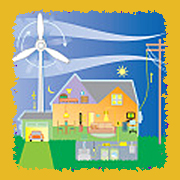Tell Me More Electrical Safety-SMART! Home
Producing Electricity
The energy resources used to generate electricity can be divided into two categories:
Nonrenewable Resources
Nonrenewable resources cannot be replenished. We can make these supplies last longer by using them wisely, but when they are gone we will not have any more.
Fossil Fuels
The majority of electricity used in the United States is generated at power plants that burn fossil fuels to heat water and make steam. The steam is highly pressurized and directed at turbine blades to make them spin.
The three forms of fossil fuels are coal, oil, and natural gas. They are known as fossil fuels because they were formed from the remains of animals or plants that lived long ago.
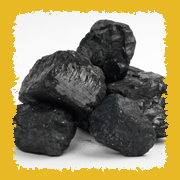
- Coal is a hard, black, rock-like substance made up of carbon, hydrogen, oxygen, nitrogen, and sulfur. The precursor to coal, called peat, is used as an energy source in many countries. Coal is found in many parts of the United States and throughout the rest of the world. Coal is extracted from the ground at large mines.

- Oil is a liquid fossil fuel, sometimes also called petroleum. It is found underground within porous rocks. Oil rigs must drill down to deposits deep below the earth's surface to obtain oil. About one fifth of the oil and petroleum products (such as gasoline, heating oil, and other products) used in the United States comes from outside our country.
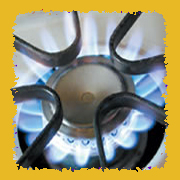
- Natural gas is made up primarily of a gas called methane. Methane gas is highly flammable and burns very cleanly. Natural gas is usually found underground along with oil. Natural gas supplies are abundant from sources in the United States and Canada.
Nuclear Power
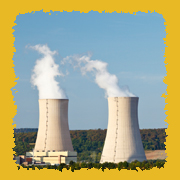 Nuclear power plants use the heat from splitting atoms to convert water into the steam that turns turbines. These plants rely on uranium, a type of metal that must be mined from the ground and specially processed. Fuel rods containing uranium are placed next to each other in a machine called a nuclear reactor. The reactor causes the uranium atoms to split, and in so doing, they release a tremendous amount of heat.
Nuclear power plants use the heat from splitting atoms to convert water into the steam that turns turbines. These plants rely on uranium, a type of metal that must be mined from the ground and specially processed. Fuel rods containing uranium are placed next to each other in a machine called a nuclear reactor. The reactor causes the uranium atoms to split, and in so doing, they release a tremendous amount of heat.
Renewable Resources
Renewable energy resources can be replenished in a short period of time, so they will never be all used up. Energy companies throughout the country are using renewable resources more and more to generate electricity.
Biomass
 Biomass is organic matter, such as agricultural waste, and wood chips and bark left over when lumber is produced. Biomass can be burned to heat water to make steam, which turns a turbine to make electricity. It can also be converted into a gas, which can be burned to do the same thing.
Biomass is organic matter, such as agricultural waste, and wood chips and bark left over when lumber is produced. Biomass can be burned to heat water to make steam, which turns a turbine to make electricity. It can also be converted into a gas, which can be burned to do the same thing.
Biomass includes energy crops like wood, straw, and other crops grown primarily for use as a fuel. Energy crops are renewable, but some, like trees, take a long time to grow. Farmers can grow trees on some of their land instead of wheat or other kinds of food. The wood is harvested regularly, cut into small chips and burned to provide heat or run small electric power plants.
A fuel generated from biomass is methane gas, a by–product of decay in landfills. As garbage rots in the ground, it gives off gases that can be collected and burned to produce heat or electricity.
[back to Renewable Resource list]
Geothermal Energy
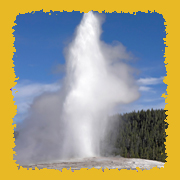 The word geothermal comes from the Greek words geo, for earth, and therme, for heat. So geothermal means "earth heat." Geothermal energy is steam (or hot water that has been converted to steam) from deep inside the earth.
The word geothermal comes from the Greek words geo, for earth, and therme, for heat. So geothermal means "earth heat." Geothermal energy is steam (or hot water that has been converted to steam) from deep inside the earth.
Our planet's interior is very hot—at its core, 4000 miles deep, temperatures may reach over 9000°F. This heat is continuously conducted from the earth's core to the surrounding layer of rock, the mantle.
There are some places around the earth where magma (hot molten earth from the mantle) pushes up through cracks into the crust near the earth's surface. Magma can heat nearby rock and water as hot as 700°F. Some of this hot water reaches the earth's surface as hot springs or geysers, and some stays trapped deep underground in cracks and porous rocks. This hot water can be used directly or converted into steam to turn turbines that generate electricity.
[back to Renewable Resource list]
Hydrogen
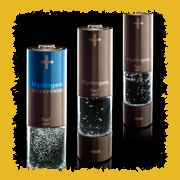 Hydrogen is a colorless, odorless gas. Hydrogen can be converted into electricity through a chemical reaction in a device called a fuel cell. Converting hydrogen into electricity produces no pollution—only water and heat.
Hydrogen is a colorless, odorless gas. Hydrogen can be converted into electricity through a chemical reaction in a device called a fuel cell. Converting hydrogen into electricity produces no pollution—only water and heat.
If the hydrogen comes from a renewable resource like landfill gas, fuel cells are considered renewable. However, if it comes from a nonrenewable resource like fossil fuels, fuel cells are considered nonrenewable.
Today, there are already some cars that run on hydrogen. In the future, hydrogen will be used to fuel vehicles and airplanes and to provide electricity to buildings.
[back to Renewable Resource list]
Hydropower
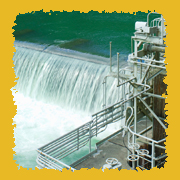 Hydroelectric plants use the power of falling water to turn the turbines that help generate electricity. Water that is stored behind a dam is released and directed through special tubes to flow against the blades of turbines and make them turn. Most hydropower facilities are found in hilly or mountainous areas. The most famous hydroelectric facility in the country is Hoover Dam.
Hydroelectric plants use the power of falling water to turn the turbines that help generate electricity. Water that is stored behind a dam is released and directed through special tubes to flow against the blades of turbines and make them turn. Most hydropower facilities are found in hilly or mountainous areas. The most famous hydroelectric facility in the country is Hoover Dam.
[back to Renewable Resource list]
Ocean Energy
 Ocean energy is a form of hydropower. Oceans cover more than 70 percent of the earth's surface, making them the world's largest solar collectors. The ocean stores thermal (heat) energy, which can be used to generate electricity using special turbine generators.
Ocean energy is a form of hydropower. Oceans cover more than 70 percent of the earth's surface, making them the world's largest solar collectors. The ocean stores thermal (heat) energy, which can be used to generate electricity using special turbine generators.
The energy of the ocean's waves and tides can also be used to generate electricity with dams that force ocean water through turbines, or with buoys embedded with turbines that spin as they shift with the movement of waves. This is called tidal energy, or wave power. The world’s first wave power station was built on the Scottish island of Islay. Other wave power stations are located in Mutriku Bay, Spain; Jaffa Port, Israel; Kaneohe Bay near Oahu, Hawaii; and Cobscook Bay on the East Coast of the United States near Eastbrook, Maine.
Scientists and engineers around the world are working on systems to use the ocean's energy on a large scale.
[back to Renewable Resource list]
Solar Energy
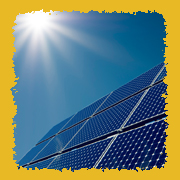 Solar energy is generated without a turbine or electromagnet. Special panels of solar cells, or modules, can capture sunlight and convert it directly into electricity. These panels are known as photovoltaic, or PV. (Photo is Greek for light, and voltaic pertains to electricity.) The electricity they produce can be used right away, fed into the power grid for others to use, or stored in a battery so it is also available on cloudy days.
Solar energy is generated without a turbine or electromagnet. Special panels of solar cells, or modules, can capture sunlight and convert it directly into electricity. These panels are known as photovoltaic, or PV. (Photo is Greek for light, and voltaic pertains to electricity.) The electricity they produce can be used right away, fed into the power grid for others to use, or stored in a battery so it is also available on cloudy days.
[back to Renewable Resource list]
Wind Power
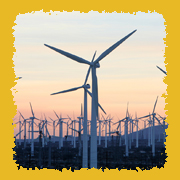 Wind power is renewable energy that uses the force of the wind to spin turbines. These spinning turbines generate electricity.
Wind power is renewable energy that uses the force of the wind to spin turbines. These spinning turbines generate electricity.
Most wind power is produced at wind farms, which are large groups of turbines in consistently windy locations. A very large wind farm can generate enough electricity for all the homes in a city of about one million people. Small wind turbines can be used for individual homes, businesses, and boats. They can be used to pump water, or the electricity can be stored in large batteries for use at another time.


